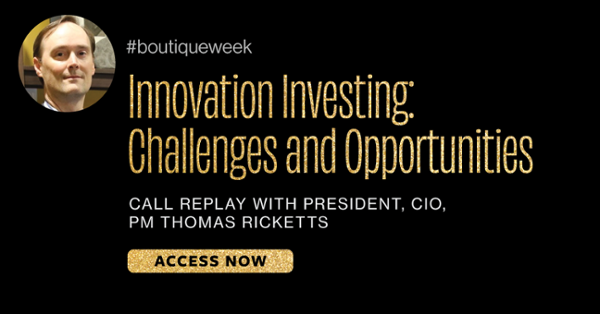As a featured presenter during Boutique Week™, a virtual event hosted by Havener Capital in May that included candid conversations with boutique investment managers, Evolutionary Tree CIO and Portfolio Manager Thomas Ricketts shared why he believes innovation investing may emerge as the third investment style, alongside growth and value. By identifying innovations on the boundary of progress, or what Mr. Ricketts refers to as the innovation frontier, he believes innovation managers can identify opportunities earlier and provide innovation investors with a fundamental advantage over traditional growth and value managers. Curious about the rationale behind his thinking? Here’s a summary of Mr. Ricketts’ Boutique Week™ conversation about the advantages of innovation investing.
Mr. Ricketts: Investment managers look for companies that can grow their earnings power over time. That’s true of both growth and value managers. But growth is just an outcome. That begs the question: What drives growth? The answer is innovation. What does this mean for investment styles?
I have found that traditional growth managers are chasing growth. They wait for growth to play out for a number of years until it eventually shows up on their growth screens. In my opinion, that's too late in the value-creation process, especially given that S curves are compressing much more quickly. As such, it becomes increasingly important to go to the source of growth, which requires identifying innovation and evolutionary shifts.
We have developed a unique investment philosophy and process specifically adapted to do just this. Our investment team reads industry trade journals and publications, talks to users and customers, and attends industry conferences. Developed through years of on-the-ground research, our team systematically identifies and tracks important innovations and innovative companies in our proprietary Innovator Database. We also track important secular trends, or what we call evolutionary shifts, in our proprietary Evolutionary Shift Database. We like to say that there is no screen for innovation. It requires a dedicated research effort to find quality innovators early on the industry lifecycle or S curve.
Meanwhile, value managers increasingly are seeing disruption in many of the industries they tend to fish in. Those industries, and virtually every industry across the economy, are becoming tech enabled. This can result in value traps.
So where does innovation investing fit into the mix and what are the advantages of being an innovation investor? Innovation investors systematically look for important innovations earlier in the value creation process. We size up innovations, analyze them to figure out which ones will go mainstream and embrace them when they're in that sweet spot on the S curve—just as they’re about to go mainstream. In my view, innovation-focused strategies and managers who have updated their investment process and their philosophy have a fundamental advantage.
Through the innovation-focused investment strategy we employ at Evolutionary Tree, we end up with a focused portfolio of quality innovators that can sustain growth over time. And while our investment results are measured against growth benchmarks, we think our focus on finding the source of growth enables us to potentially get ahead of those benchmarks and ahead of traditional growth managers.


